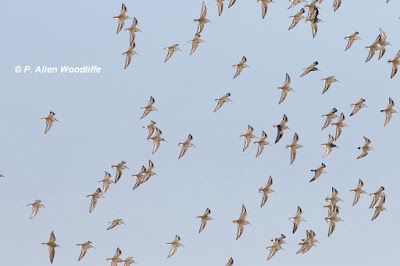Yesterday I went to Erieau to see what was new. The birds were fairly typical, but I noticed this.
The wave action had been coming over the edge of the pier fairly vigorously during one of the storms, and the building closest to the channel, while having not been in great shape before, had taken some serious blows by the pounding waves. I'm not sure what the future of this building is. It has just been used for storing odds and ends for some time now, and I don't know if anyone has the need to repair it.
One of the birdy things I noticed while near the waterfront and pier area were several flocks of Rusty Blackbirds, feeding on the grassy areas, or on the pier, or just about anywhere else. The warm temperature of the day caused a lot of gnats to be around, and Rusties were busily feeding on them wherever they could find them. One Rusty was especially interested in this old building...
.....and was checking out the myriad gnats around the eaves trough and roof area as well.
As usual, there were thousands of waterfowl out on Rondeau Bay. There had to be at least 1000 American Coot, and probably ten thousand ducks of various species. American Wigeon, Gadwall, Mallard, Redhead and the like were the most numerous. The light was good for checking them out with a 'scope. I was hoping for a Eurasian Wigeon, almost a guarantee to be somewhere on the bay at this time of year.
Bingo!
It wasn't as close as I would have liked, but quite visible nonetheless through the 'scope.....not quite as good using a telephoto lens even with heavy cropping, however. It isn't quite in full breeding plumage, as other shots show a fair bit of grayish on the back and sides, but the brick red head and the yellow frontal stripe and the lack of a dark area at the gape are all good indicators. Being right beside a male American Wigeon in this photo is a good comparison. Hopefully it will stick around for a few weeks and be in a brighter, fuller breeding plumage before winter sets in.
There were others out looking through the ducks and shorebirds in the area.
 |
| McArthur sighting |
 |
| White-rump |
 |
| Lesser Yellowlegs |
Great Egrets are still around, although they are now showing up as 'Rare for this date and location' on ebird. Time to get the ebird filters updated!
FYI, another local site is available for birding, butterflies, botanizing, etc....the Fletcher Ponds. Technically they have been open and available for several years, but I just recently found out they were not posted. I had been there during the first Breeding Bird Atlas in the early 1980s, but it was posted for a few years at some point after. Now there is a small parking lot and a trail back to a series of wetland/pond areas, with shrubby areas and a few scattered mature trees. The access lane is located on the west side of Merlin Line, just south of Fletcher and almost immediately south of the Fletcher United Church. I have only been there once in recent weeks, and just got a few typical autumn migrants during my short visit, including this Blue-headed Vireo.
There were a few butterflies, including sulphurs, Monarchs and this Common Buckeye.
Some Painted Turtles were getting in some late season sun in the various ponds.
But given that it is largely in an agricultural landscape, except for the decommissioned railroad slightly to the north, it may attract birds looking for something more natural than corn or soybeans. I will definitely be checking it out from time to time. Maybe a spot to attract a vagrant flycatcher???














Good to see that you got to see the Eurasian! I'm assuming it's the same one that I saw on the 15th - same area, anyway. Were you standing on the tower of the Rail Trail or were you at the end of Bayview Street?
ReplyDeleteI could see the raft from the tower, but they were too far away to ID them easily so I went to the south end of Bayview St.
DeleteAllen, great posting as always. I think the shorebird in the bottom left might be a pectoral sandpiper. It has a slightly browner tone, and is sometimes found with Dulin and White rumps. The shorebirds in flight photo from my recent Blenheim posting seems to have a pectoral in the mix with a browner tone and yellow legs trailing. I could be wrong though!-dm
ReplyDeleteHi Dwayne....good point about the PESA. I had considered it, but since they are typically as large or even slightly larger than DUNL, I didn't pursue that thought. It is possible that the angle of the bird made it seem slightly smaller than DUNL....or there could just be some slight variations in size. But the pattern fits. Thanks.
DeleteAllen